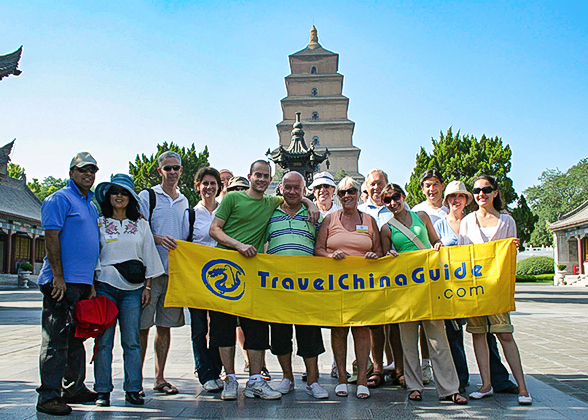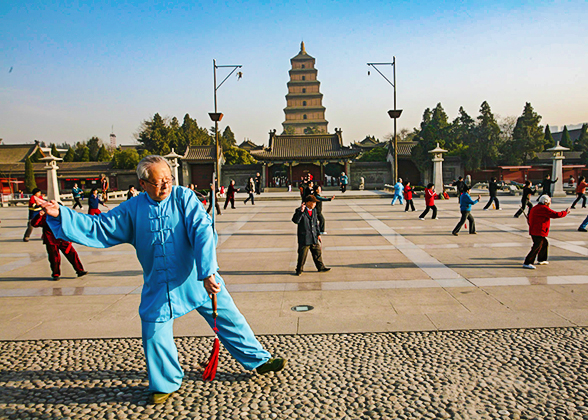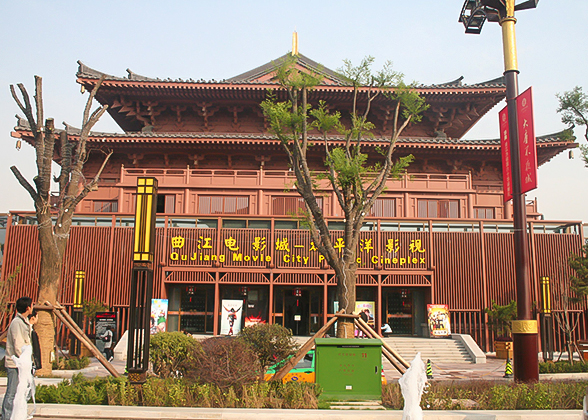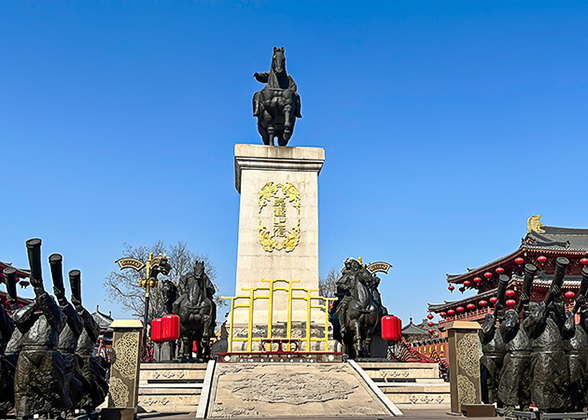Squares and Gardens around Giant Wild Goose Pagoda
Around the Xi'an Da Ci'en Temple with the magnificent Giant Wild Goose Pagoda inside, there are a number of squares and gardens built to present the grandness of the pagoda and the cultural spirit of the Tang Dynasty (618 - 907). To the north is the famous North Square with a spectacular musical fountain; to the east are the Tang Ci'en Temple Site Park and the East Garden; to the west lies the West Garden; and to the south the South Square sits in front of the main gate of the Da Ci'en Temple and the Great Tang All Day Mall extends further southwards.
North Square
|
|
The T-shape musical fountain and waterscape area covers an area of 15,000 sq m (about 17,940 sq yd). Possessing 1,024 burner caps, this fountain is divided into three areas: Hundred-meter Waterfall Pool, Eight-level Plunge Pool and Prelude Music Pool. The main music played during the fountain performances is a symphony - Water Phantom of Tang.
When the music starts, the central area of the square is full of different shapes of fountain sprays showing 22 matrix patterns. Some are particularly designed with advanced science and technology, including the lotuses, hundred-meter running spring, sea of clouds, flying gulls, sixty-meter-high water column and the laser water curtain. In particular, the ‘Fire Fountain’ of 60 m (about 197 ft) in width and 20 m (about 65.6 ft) in height spurting from water and blowing up in the air attracts much more attention. The effect of the fountain performance is perfectly designed by combining the music, lights, water and colors, and thus the fountain at night, when colorful water sprays fly in the air like thousands of sparkling fairies, is more attractive than that in the daytime.
Admission Fee: Free.
Show Time of the Musical Fountain
| Admission Fee | Free | |
| Timetable | Jun. 10 – Oct. 5 | Mon., Wed. – Fri.: 12:00, 21:00 |
| Tue.:21:00 | ||
| Feb. – Jun. 9; Oct. 6 – Oct. 31 | Mon., Wed. – Fri.: 12:00, 20:30 | |
| Tue.:20:30 | ||
| Note: 1. Extra performances in weekends and holidays are at 14:00, 16:00 and 18:00; 2. No show from Nov. to Jan., expect the Chinese New Year Holiday. | ||
Tip: Due to the extraordinary number of visitors, for a good angle of view, you are suggested to be on the scene 20 minutes before the musical fountain show starts. Don't get too close to the burner caps. Also, please watch out your belongings especially cameras while you are enjoying the waterscape.
At the entrance of the square stands a cupreous statue of an ancient book telling the prosperity of the Tang Dynasty. Behind the statue are Buddhist beacons and culture columns. The two nine-meter-high Buddhist beacons are the symbol of North Square. The bodies of the beacons are designed to show the spirit of Buddhism based on the patterns of the Mogao Caves in Dunhuang.
On the two sides of the fountain, there are statues of the elites of the Tang Dynasty. The development of Tang Dynasty in Chinese history is unparalleled. At that time, many elites of various fields emerged, including the famous poets and scholars such as Li Bai, Du Fu, Wang Wei, and Han Yu, outstanding calligrapher Huai Su, and the ‘King of Chinese Medicine’ - Sun Simiao etc. Besides, the delicate ground relievos show the excellent calligraphy work and the auspicious patterns of the Tang. Even the street lamp chimneys and the stone railings around are covered with well-known Chinese poems.
East and West Pedestrian Streets
Tang Ci'en Temple Site Park
East Garden
West Garden
South Square
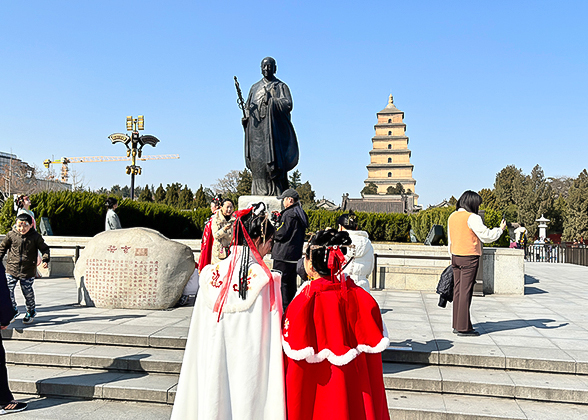 |
| South Square |
Great Tang All Day Mall, with a width of 480 meters (525 yards), extends 1,500 meters (1,640 yards) southwards from the South Square of the Giant Wild Goose Pagoda, across the Zhenguan Culture Square and Kaiyuan Ceremony Square, and finally reaches the Tang City Wall Relics Park at its southern end. It is a comprehensive culture center and shopping mall with sights featuring the style of the Tang Dynasty as well as shopping, food and recreation facilities.
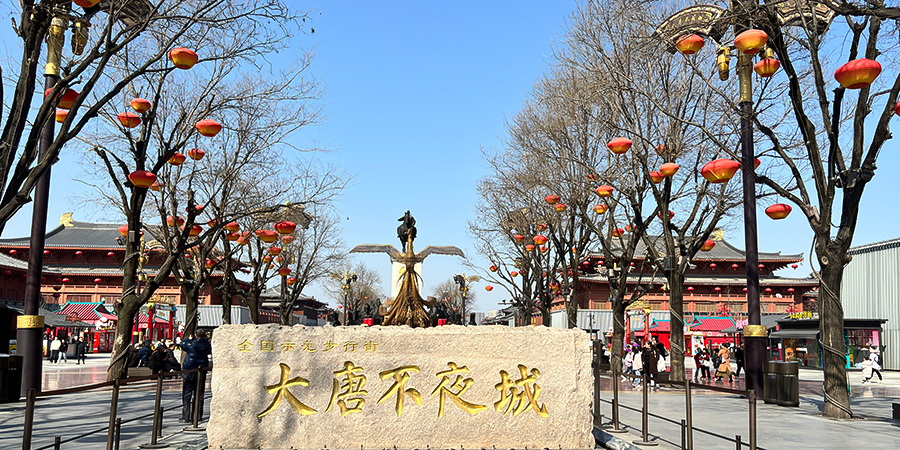
The large statuary landscape avenue on the axis combines nine groups of theme statuaries with modernized waterscape system and light system. The statuaries depict the Tang emperors, famous historical figures, historical heroes, classical art articles etc, showing the dominant achievements of the Tang Dynasty in religion, literature, art and technology. Zhenguan (the reign title of Emperor Taizong of the Tang Dynasty) Monument is the typical and symbolized building in the Great Tang All Day Mall. It is composed of a main statue of Emperor Taizong with a height of 5.95 meters (19.5 feet) on top of the tall monument and a group of statuaries of his attendants, including 12 buglers, 12 standard-bearers, 2 drummers and 6 court officials. On both sides of the avenue, there are six blocks built in the Tang Dynasty style, among which the Xi'an Concert Hall, Xi'an Grand Theater, Qujiang Cinema and Shaanxi Artists Gallery are the most attractive.
|
|
How to get to Squares and Gardens of Giant Wild Goose Pagoda
2. Take bus 5, 19, 21, 22, 23, 24, 27, 30, 34, 41, 44, 224, 242, 271, 307, 400, 401, 408, 500, 521, 526, 527, 601, 606, 609, 701, Qujiang Tourist Bus, Huan Shan Tour Bus 1 & 2, Tourist Bus Line 6 & 8 & 9 and get off at Dayanta Station.
Xi'an Bus / Metro Search
3. Taxi: It costs about CNY 30 from the Xi'an Railway Station to the Giant Wild Goose Pagoda.
![]() Other Nearby Attractions:
Other Nearby Attractions:![]() Shaanxi History Museum
Shaanxi History Museum![]() Tang Paradise
Tang Paradise![]() Qujiang Ocean Park
Qujiang Ocean Park![]() Qujiang Pool Park
Qujiang Pool Park![]() Cool Cave (Hanyao)
Cool Cave (Hanyao)![]() The Tomb of the Second Emperor of Qin Dynasty (The Tomb of Hu Hai)
The Tomb of the Second Emperor of Qin Dynasty (The Tomb of Hu Hai)
- Last updated on Aug. 14, 2024 by Catherine He -
